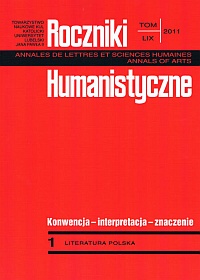On „Possibility” in the Science Fiction Convention (On the Example of Stanisław Lem's Fiction)
Abstract
The category of “possibility” is constitutive for the science fiction convention, and for concepts worked out by the theory of possible worlds (such as: actual world and possible worlds, availability, completeness, non-contradiction, trans-world identification or a universe of worlds) are here more useful for describing the created reality than in other types of literature.
Hence, in Part I of the article the author reviews the rules for building the presented world in science fiction literature in connection with basic assumptions of the conception of possible worlds. Part II is devoted to a classification of Stanisław Lem's fiction made from the point of view of the theory of possible worlds. In the discussed works the author distinguishes six groups of works exploring the category of “possibility” in various ways. Possible worlds, presented and not presented, co-existing worlds, impossible worlds, worlds possible as texts, worlds possible as literary motifs – are the six types of the created possible worlds in Stanisław Lem's works.
Copyright (c) 2011 Roczniki Humanistyczne

This work is licensed under a Creative Commons Attribution-NonCommercial-NoDerivatives 4.0 International License.





